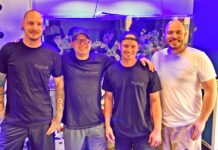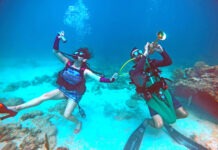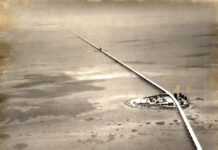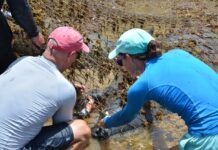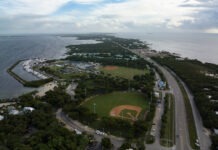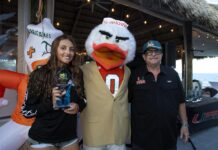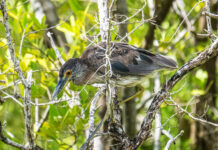The highway was jammed, though not, as Springsteen said, with broken heroes on a last chance power drive. Mostly it was dump trucks, RVs and rental Mustangs – the usual Overseas Highway stuff, which might have been a disappointment to the turkey vultures flying overhead. They would have appreciated some carnage and carrion.
According to the folks at the Florida Keys Hawkwatch, which ended on Nov. 29, 13,567 turkey vultures migrated into the Keys this fall. Driving north to Miami, it seemed as if all of them had decided to hang out over the road.
There are a couple reasons there were so many of them overhead. One is that to save energy, turkey vultures will often gain altitude by rising up on thermals, columns of warm air that swirl hundreds of feet up. Since concrete and tar tend to retain so much heat, highways and parking lots tend to create pretty good thermals, especially in places like Florida. And who would not take advantage of a free ride on an invisible elevator?
Also, turkey vultures don’t tend to spend a lot of time flying over water – there aren’t many thermals there – and since landmasses in the Keys can be so narrow, there’s not much room for them to spread out, and the highway is the central terrestrial feature.
Highways also have a lot of roadkill, a large part of the diet for turkey vultures in the modern world. Though related to hawks and eagles, they are a little less sporting than their cousins.
The details of the turkey vulture’s life history are not for the squeamish.
They are carnivores, though unlike most raptors, everything but, say, one brick of their food pyramid is dead things. While they are technically birds of prey, they don’t seem to have the skills or inclination to kill anything. Physiologically, they lack the strong feet or flesh-tearing bill of a peregrine falcon or a Cooper’s hawk.
If they find small dead animals – squirrels, mice, birds, iguanas – they can eat them pretty quickly post mortem. The same with carrion killed, partially eaten, and abandoned by other predators. But with larger, intact animals with thicker skin – deer, cattle, hogs – things generally need to ripen, and ingress is often made through the softer parts of the anatomy – mouth, nose, eyes, and let’s just say the pelvic region.
Turkey vultures can find their meals by sight, but they mostly use their highly evolved sense of smell. To test this, scientists once left 74 dead chickens in a canopied forest, where they could not be seen. The turkey vultures found 71 of those chickens within three days, with few of them being found when they were fresh, and most of them found after a full day.
Other species sometimes take advantage of their highly adept olfactory senses. Black vultures, who have a weak sense of smell, will often fly higher than turkey vultures, and then follow them in toward the carrion, and then compete with them for a share. Natural gas companies, trying to find leaks in their pipelines, will sometimes add odorants with scents similar to decomposing corpses into the mix, and then look to see where the turkey vultures congregate.
While they rarely venture away from land, they have been known to feed from the floating corpses of alligators and manatees. When they eat dead skunks, they have been known to swallow the scent gland whole. They have been observed feeding on the feces of coyotes, sea lions and cows, but most likely they were prospecting for insects and undigested bits.
Turkey vultures are, of course, purpose-built for this life. For starters, they don’t have any feathers on their head, which makes it easier to shove their faces into carcasses and pull out the goopy stuff without fouling their plumage.
Also, they have the strongest stomach acid of any animal on the planet – up to 100 times more acidic than a human’s. They can digest just about anything. Things that would sicken or kill most other animals have no effect on them. They are immune to the pathogens that cause rabies, botulism, cholera, anthrax and many other illnesses.
This is good for them as a species, as they occupy a large portion of an ecological niche that does not have a great deal of appeal for other species. But also, they serve a massive good for ecosystems as a whole – slowly decontaminating the world and making it safer for everyone else. This was exemplified in India in the 1980s and ’90s, when the populations of several species of vultures began to crash due to the agricultural use of a drug called diclofenac, which turns out to be one of the few ingestible things lethal to vultures. The decline caused feral dog populations to explode, as well as for drinking water sources to be contaminated, bringing about increases in lethal cases of rabies, anthrax and the plague in humans, and bringing about thousands of deaths.
For all of these reasons, turkey vultures don’t have a lot of predators. Other species tend to leave them alone, maybe not so much out of respect but through avoidance, possibly further inspired by one other revulsive habit of theirs: Turkey vultures practice something called urohidrosis, which is the habit of excreting down their legs in order to cool themselves in hot weather. (It often gives their legs a whitish appearance, when the skin is, in fact, red.)
So if you see them – hanging up there in the sky, or sitting in a tree or by the side of the road – maybe appreciate them for what they do, but don’t get too close. Also, drive carefully.
